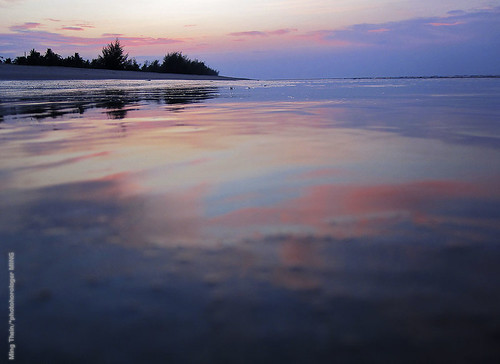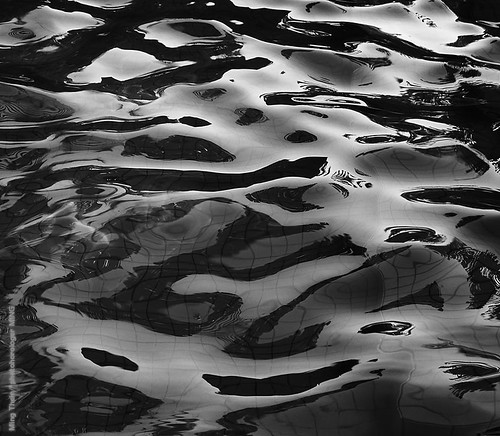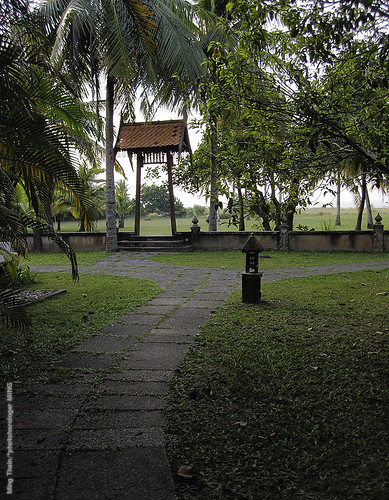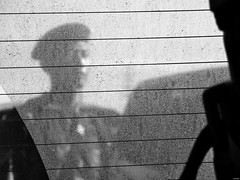Canon SD780IS/ IXUS 100IS
Nikon D90, AFS 105/2.8 VR Micro with SB900.
Introduction
I'm going to refer to the camera as the 100IS throughout this review to avoid confusion and retyping. As mentioned in a much earlier post, I came over with one of those rare cases of camera lust for the sake of lust - I like this thing purely because of the way it looks, and the size, not anything in particular on the spec sheet - though it does have a couple of neat tricks I'll talk about later. As with all of our reviews, this will be a user experience review with specific comments on image quality where necessary. We're photographers and leave the detailed pixel-level comparisons to sites like DPR.

Yes, it's small. Very small. And only 18mm thick all the way round, with no protrusions - it fits nicely into a pocket.
Nikon D90, AFS 105/2.8 VR Micro with SB900
Features and specifications
It's your standard point and shoot; 12 MP on a rather high density 1/2.3" sensor. I'd personally have preferred even 6 really good MP rather than 12 so-so ones, but as it turns out the camera isn't that bad after all. The lens is a 3x, 33-100/3.2-5.8 thingy that won't win speed or reach contests, but it does have a gyro element to provide optical stabilization. You get a 2.5" LCD, 720P HD movie mode, and amazingly, a miniscule optical zoom finder (actually, the smallest finder I've seen on any camera, period) which is pretty much useless for framing, but not bad for when your shutter speed is dodgy and you need to brace the tiny camera against your forehead. It takes SD/SDHC cards, and there's a HDMI out port.


Mini hut reflections
Canon IXUS 100 IS
Build quality and handling
With something this small and smooth, there are bound to be handling challenges. There's no grip anywhere, so you're best off using two hands - especially when trying to press the recessed buttons on the back, which are quite difficult to distinguish between, particularly in the dark. The camera itself is metal, though the trim that runs between the two shells is plastic, as are the buttons and the memory card/ battery door on the bottom. The latter item is extremely flimsy feeling and I suspect will break quite easily if not handled with care. You do get a metal tripod mount, though. The mix of textures used in the construction actually makes it quite a nicely tactile object to use, and what attracted it to me in the first place. Aside from the stealthy all-black finish, there are also ordinary silver, lipstick red and pimpy gold options available.
Canon IXUS 100 IS
Lens: Canon 5.9-17.9mm 1:3.2-5.8 (33-100 equivalent)
Considering it's size, it's actually surprisingly decent. I think most of the softness I see in the images is due to noise reduction and JPEG processing artifacts rather than lens deficiencies. It's better at wideangle than telephoto though, and has a tendency to flare oddly at the long end. There's no CA that I've seen yet. It isn't up to the standard of the Leica-designed lenses on the Panasonics though. If only this had the 25-125 equivalent on the FX48. Actually, it's not that much of a problem in normal use - most of the time you don't want wide for grab shots, so 33mm is fine. What would be nice is if you could program where in the zoom range the camera started up - I'd probably pick either 35 or 50mm.
Canon IXUS 100 IS
Controls, ease of use and speed
Quite simply, easy, and fast for what it is. I don't think it's quite as fast as my LX3 was, but it's pretty close. The control layout is traditional Canon. It lacks the scrolling D-pad, but I think that's actually a good thing: on a camera this small it'd be far too fiddly to use accurately. There are shortcuts for the usual functions on the D-pad, and a function menu to bring up everything else. Startup and shutdown time is in the region of 1.5 seconds, and shot to shot is virtually lag-free (I'm using a 4GB Sandisk Ducati Edition Class 6 SDHC card).
Canon IXUS 100 IS
Autofocus performance
Focusing is surprisingly snappy despite the slow lens, and if you leave it on Face Detect Ai AF it almost always manages to pick up any people in the scene. It doesn't track moving objects very well, but with the small sensor you can always prefocus and rely on huge DoF to cover subject movement. Minimum focus distance is 5cm in macro mode at the wide end.
Canon IXUS 100 IS
IS performance
The stabilizer doesn't seem quite as effective as that on the Panasonics, but it's definitely better than nothing, and I've had some surprising shots which turned out sharp despite shooting one-handed under iffy lighting. The thing you have to remember with ultracompacts is that you actually need a much higher shutter speed for a motion-blur free picture because they simply don't have the mass to dampen inadvertent photographer motion. Bottom line: you get about 1 extra stop over the 1/focal length rule.
Canon IXUS 100 IS
LCD and image review
I've got a complaint and praise here. The LCD is bright - too bright - and too sharp. It's not accurate in the sense that it doesn't properly represent the image; what looks great and well exposed on the LCD comes out mushy and horrible on a computer. You MUST use the histogram for accurate exposure.
On the positive side, this camera has the best image review options I've seen in a compact. You can set it to show you just the image, the image with a histogram and flashing highlights warning, or a focus point check; unlike Canon DSLRs, you can zoom and delete images from the instant review. You can also jump between focusing points. However, you have to enter full playback mode to jump between images (which you can also do while magnified; useful when comparing images for sharpness from a burst).
And it's shooting priority! A tap of the shutter button returns you to record mode at any time; playback mode is on a button and can also be directly accessed when the power is off. This is the biggest gripe I've got about the latest generation Panasonic cameras, which are so well thought out except for the glaringly obvious flaw of putting playback mode on a switch.
Canon IXUS 100 IS
Metering performance
If you go by the LCD, the meter looks great. But it's conservative and tends to underexpose, so a good rule of thumb is add a stop if your subject is mostly white and subtract one if it's mostly black. Ideally, you should check the histogram - this is especially important because on small sensor cameras like this one, one stop can make the difference between a great image and noisy unrecoverable mush. Matrix, spot and centerweight options are available.
Image quality and noise
Quite honestly, with few exceptions, all compacts these days have fairly similar image quality. The main difference is in how the camera handles noise reduction; Canons tend to be smoother but significantly less detailed. The 100 IS is no exception: detail at base ISO 80 is great, but it rapidly deteriorates to the point where ISO 400 is frequently detail-free, though I've had some acceptable images at ISO 800.
Color isn't accurate at all - honestly, what were you expecting from a JPEG, sRGB only camera? Blues shift towards cyan/green, and reds blow very quickly. It's an unavoidable consequence of having a small sensor with limited dynamic range.
Speaking of dynamic range, it's actually surprisingly good at ISO 80; perhaps 7-8 stops; by the time you get to ISO 800, useable dynamic range is about 4-5 stops at most. And at all costs avoid the i-contrast option; it's too strong and produces very odd histograms where both shadows and highlights land up in the midtones, and as a result images look flat and suffer from gross color shifts - again, usually in the red channel.
In bright light, the camera has a tendency to favor smaller apertures over higher shutter speeds; this leads to noticeable diffraction softening. A pity Canon didn't do it the other way around, because this would have helped both camera shake and resolution.

Sunset reflection
Canon IXUS 100 IS
Battery life
Surprisingly good, but the gauge is unreliable (and only has three segments, which I take to be full, half, and "DANGER WILL ROBINSON!"). I'm guessing you could get around 300-400 images with the flash off, and if you limit LCD time. It's a tiny little Li-ion cell, and replacements are expensive. Make sure to charge it before leaving the house.
Conclusion
I bought this because a) I love the idea of a stealthy pocket camera; image quality only has to be acceptable; b) okay, I'm shallow: it looks great. Does it succeed for those two purposes? Undoubtedly yes. There's been a bit of a learning curve with the metering - I would have had many more keepers if I'd known the LCD was so misleading (towards the end of the weekend I was bracketing manually). It's actually so handy that I left the M8 in the hotel room all weekend and only shot with the 100 IS; part of it is new gadget disease but I suspect that it's also partly convenience.
The reality is that this is a camera for when you don't want to carry a camera; when your primary purpose isn't photography (and even an M8 would be too much). It succeeds at that and is actually rather enjoyable to use. It even has neat features like the host of review options. It's faster than the M8 at pretty much everything except release lag. Image quality is pretty good when the light is good (I'd say switch to something with a larger sensor around dusk) - and it's definitely a step above the 'emergency use only' kind of camera that comes lodged in the back of a cellphone. If the M8 is stealthy, this thing is invisible. And that's already gotten me a few shots even the M8 wouldn't have been able to get - if only there was a hyperfocal setting to cut AF lag.
I've owned the LX3, and shot with a G10 and P6000 for an extended period - the serious compacts - and while they were enjoyable, they were all big and unpocketable enough that I wish I'd just carried a proper camera. Result: the point and shoot got left at home all the time, defeating the point. Yes, the image quality of the LX3 is the best I've ever seen in a compact, but under the conditions I'd use it, it's pretty darn close to the 100 IS. You don't need A/S/M modes because they make little difference with a small sensor. The lens isn't anywhere near as good as the LX3 (and practically it has a ~3 stop advantage), but the only one I can pocket and not notice until I need it is the 100 IS - which to me is the whole point. It does what it's meant to without fuss, and for that I'd highly recommend one if a pocket camera is what you're looking for.











Thanks for the very informative review.
ReplyDeleteGot this camera a little while ago and love it to bits. Some things I've discovered that might add to your enjoyment:
ReplyDelete1) Set the camera to M2 size JPEGs; you gain about a stop before noise gets too horrible, I happily shoot at ISO 800.
2) If you do (1) above then in the menu you can select Digital zoom 1.5x and you get a 50mm equivalent lens when you turn on the camera, also the viewfinder then covers a little more than 100%, and becomes almost usable.
3) Use Auto Focus Lock (AFL) and Auto Exposure Lock (AEL) together and the shutter lag becomes practically zero. I think you have to be in Program mode to use these.
Happy snapping.
this post helped convince me to buy this camera. Thanks for sharing!
ReplyDelete